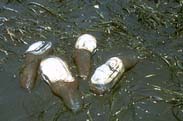 | Water Module |
|
|

Field Preparation
|
Shellfish
Shellfish are an important part of the marine ecosystem. Often they are considered the "canary in the mine shaft" - an indicator of the quality of the water. Pollution may not actually be harmful to the shellfish, but they absorb pathogens
which can make humans who eat them, ill. The state Department of Health regulates harvest from shellfish beds according to the
degree or risk of pollution from point and non-point sources.
Water QualityThroughout time, the shellfish industry has been challenged by a variety of water quality issues, including industrial pollution and non-point pollution from such sources as failing septic systems and agricultural and urban runoff. Shellfish are filter-feeders, so water pollution, bacteria and toxins, accumulate in their tissue. Because oysters, clams, scallops and mussels absorb so much pollution, their presence along beaches improves the water quality. The pollution doesn't usually harm the shellfish, but eating shellfish from polluted shores could be dangerous. All commercial shellfish beds must be certified by the Washington Department of Health for the clams, mussels and oysters grown there to be legally sold. The state monitors for pollutants in the waters, as well as Paralytic Shellfish Poisoning (PSP) to make sure the shellfish are safe to eat. More nutrients; Good News and Bad NewsWith more people living along the coastal watersheds, many of the bays and inlets in Puget Sound are receiving more nutrients from upstream. In Southern Puget Sound, the results have been dramatic. The Tacoma Narrows acts like a bottleneck and traps nutrients in the southern Sound. Incredible algal blooms result. Nutrient sources include:
Nutrients are beneficial to shellfish, up to a point. They encourage faster growth, because the shellfish have more algae to eat. In Totlen Inlet, 12 years ago it took an average of 4 years to grow a mature oyster. Today, because of the increased algae, it takes only 18-24 months. Bad News
Algae summer blooms can overwhelm the oysters when they are already stressed from the summer spawning season. "Summer mortality" can kill up to 50% of a crop in the course of a week. Just like in lakes, when algae bloom and then die, that uses up dissolved oxygen, causing death for fish, shellfish and other aquatic life.
|

Sitemap | Contact Us |
|
